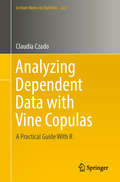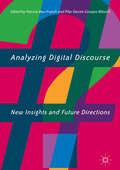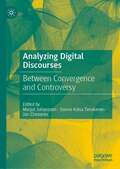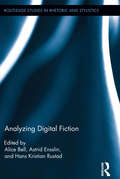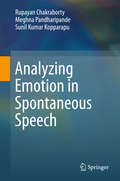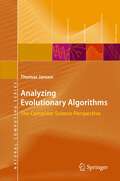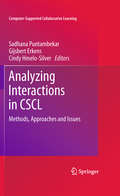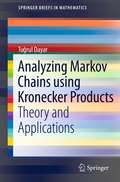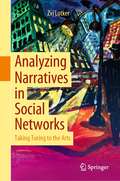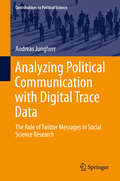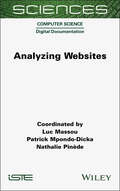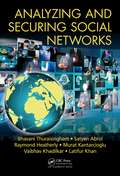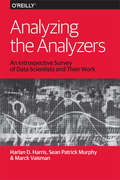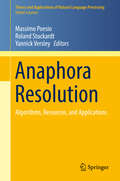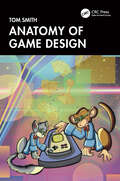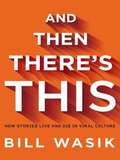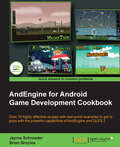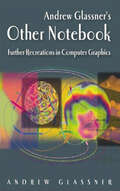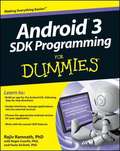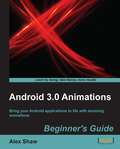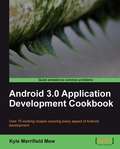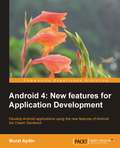- Table View
- List View
Analyzing Dependent Data with Vine Copulas: A Practical Guide With R (Lecture Notes in Statistics #222)
by Claudia CzadoThis textbook provides a step-by-step introduction to the class of vine copulas, their statistical inference and applications. It focuses on statistical estimation and selection methods for vine copulas in data applications. These flexible copula models can successfully accommodate any form of tail dependence and are vital to many applications in finance, insurance, hydrology, marketing, engineering, chemistry, aviation, climatology and health.The book explains the pair-copula construction principles underlying these statistical models and discusses how to perform model selection and inference. It also derives simulation algorithms and presents real-world examples to illustrate the methodological concepts. The book includes numerous exercises that facilitate and deepen readers’ understanding, and demonstrates how the R package VineCopula can be used to explore and build statistical dependence models from scratch. In closing, the book provides insights into recent developments and open research questions in vine copula based modeling.The book is intended for students as well as statisticians, data analysts and any other quantitatively oriented researchers who are new to the field of vine copulas. Accordingly, it provides the necessary background in multivariate statistics and copula theory for exploratory data tools, so that readers only need a basic grasp of statistics and probability.
Analyzing Digital Discourse: New Insights and Future Directions
by Pilar Garcés-Conejos Blitvich Patricia Bou-FranchThis innovative edited collection presents new insights into emerging debates around digital communication practices. It brings together research by leading international experts to examine methods and approaches, multimodality, face and identity, across five thematically organised sections. Its contributors revise current paradigms in view of past, present, and future research and analyse how users deploy the wealth of multimodal resources afforded by digital technologies to undertake tasks and to enact identity. In its concluding section it identifies the ideologies that underpin the construction of digital texts in the social world. This important contribution to digital discourse studies will have interdisciplinary appeal across the fields of linguistics, socio-linguistics, pragmatics, discourse analysis, gender studies, multimodality, media and communication studies.
Analyzing Digital Discourses: Between Convergence and Controversy
by Marjut Johansson Sanna-Kaisa Tanskanen Jan ChovanecThis book contributes to the scholarly debate on the forms and patterns of interaction and discourse in modern digital communication by probing some of the social functions that online communication has for its users. An array of experts and scholars in the field address a range of forms of social interaction and discourses expressed by users on social networks and in public media. Social functions are reflected through linguistic and discursive practices that are either those of ‘convergence’ or ‘controversy’ in terms of how the discourse participants handle interpersonal relations or how they construct meanings in discourses. In this sense, the book elaborates on some very central concerns in the area of digital discourse analysis that have been reported within the last decade from various methodological perspectives ranging from sociolinguistics and pragmatics to corpus linguistics. This edited collection will be of particular interest to scholars and students in the fields of digital discourse analysis, pragmatics, sociolinguistics, social media and communication, and media and cultural studies.
Analyzing Digital Fiction: Analyzing Digital Fiction (Routledge Studies in Rhetoric and Stylistics)
by Astrid Ensslin Alice Bell Hans Kristian RustadWritten for and read on a computer screen, digital fiction pursues its verbal, discursive and conceptual complexity through the digital medium. It is fiction whose structure, form and meaning are dictated by the digital context in which it is produced and requires analytical approaches that are sensitive to its status as a digital artifact. Analyzing Digital Fiction offers a collection of pioneering analyses based on replicable methodological frameworks. Chapters include analyses of hypertext fiction, Flash fiction, Twitter fiction and videogames with approaches taken from narratology, stylistics, semiotics and ludology. Essays propose ways in which digital environments can expand, challenge and test the limits of literary theories which have, until recently, predominantly been based on models and analyses of print texts.
Analyzing Emotion in Spontaneous Speech
by Sunil Kumar Kopparapu Rupayan Chakraborty Meghna PandharipandeThis book captures the current challenges in automatic recognition of emotion in spontaneous speech and makes an effort to explain, elaborate, and propose possible solutions. Intelligent human-computer interaction (iHCI) systems thrive on several technologies like automatic speech recognition (ASR); speaker identification; language identification; image and video recognition; affect/mood/emotion analysis; and recognition, to name a few. Given the importance of spontaneity in any human-machine conversational speech, reliable recognition of emotion from naturally spoken spontaneous speech is crucial. While emotions, when explicitly demonstrated by an actor, are easy for a machine to recognize, the same is not true in the case of day-to-day, naturally spoken spontaneous speech. The book explores several reasons behind this, but one of the main reasons for this is that people, especially non-actors, do not explicitly demonstrate their emotion when they speak, thus making it difficult for machines to distinguish one emotion from another that is embedded in their spoken speech. This short book, based on some of authors' previously published books, in the area of audio emotion analysis, identifies the practical challenges in analysing emotions in spontaneous speech and puts forward several possible solutions that can assist in robustly determining the emotions expressed in spontaneous speech.
Analyzing Evolutionary Algorithms: The Computer Science Perspective (Natural Computing Series)
by Thomas JansenEvolutionary algorithms is a class of randomized heuristics inspired by natural evolution. They are applied in many different contexts, in particular in optimization, and analysis of such algorithms has seen tremendous advances in recent years. In this book the author provides an introduction to the methods used to analyze evolutionary algorithms and other randomized search heuristics. He starts with an algorithmic and modular perspective and gives guidelines for the design of evolutionary algorithms. He then places the approach in the broader research context with a chapter on theoretical perspectives. By adopting a complexity-theoretical perspective, he derives general limitations for black-box optimization, yielding lower bounds on the performance of evolutionary algorithms, and then develops general methods for deriving upper and lower bounds step by step. This main part is followed by a chapter covering practical applications of these methods. The notational and mathematical basics are covered in an appendix, the results presented are derived in detail, and each chapter ends with detailed comments and pointers to further reading. So the book is a useful reference for both graduate students and researchers engaged with the theoretical analysis of such algorithms.
Analyzing Interactions in CSCL: Methods, Approaches and Issues (Computer-Supported Collaborative Learning Series #12)
by Gijsbert Erkens Sadhana Puntambekar Cindy Hmelo-SilverAnalyzing Interactions in CSCL: Methodology, Approaches, and Issues deepens the understanding of ways to document and analyze interactions in CSCL and informs the design of the next generation of CSCL tools. It provides researchers with several alternative methodologies, theoretical underpinnings of the methods used, data indicating how the method worked, guidance for using the methods, implications for understanding collaborative processes and their effect on learning outcomes and implications for design. CSCL research tends to span across several disciplines such as education, psychology, computer science and artificial intelligence. As a result, the methods for data collection and analysis are interdisciplinary, from fields such as sociology, anthropology, psychology, computer science, and artificial intelligence. This book brings perspectives together, and provides researchers with an array of methodologies to document and analyze collaborative interactions.
Analyzing Markov Chains using Kronecker Products: Theory and Applications (SpringerBriefs in Mathematics)
by Tugrul DayarKronecker products are used to define the underlying Markov chain (MC) in various modeling formalisms, including compositional Markovian models, hierarchical Markovian models, and stochastic process algebras. The motivation behind using a Kronecker structured representation rather than a flat one is to alleviate the storage requirements associated with the MC. With this approach, systems that are an order of magnitude larger can be analyzed on the same platform. The developments in the solution of such MCs are reviewed from an algebraic point of view and possible areas for further research are indicated with an emphasis on preprocessing using reordering, grouping, and lumping and numerical analysis using block iterative, preconditioned projection, multilevel, decompositional, and matrix analytic methods. Case studies from closed queueing networks and stochastic chemical kinetics are provided to motivate decompositional and matrix analytic methods, respectively.
Analyzing Narratives in Social Networks: Taking Turing to the Arts
by Zvi LotkerThis book uses literature as a wrench to pry open social networks and to ask different questions than have been asked about social networks previously. The book emphasizes the story-telling aspect of social networks, as well as the connection between narrative and social networks by incorporating narrative, dynamic networks, and time. Thus, it constructs a bridge between literature, digital humanities, and social networks. This book is a pioneering work that attempts to express social and philosophic constructs in mathematical terms.The material used to test the algorithms is texts intended for performance, such as plays, film scripts, and radio plays; mathematical representations of the texts, or “literature networks”, are then used to analyze the social networks found in the respective texts. By using literature networks and their accompanying narratives, along with their supporting analyses, this book allows for a novel approach to social network analysis.
Analyzing Non-Textual Content Elements to Detect Academic Plagiarism
by Norman MeuschkeIdentifying plagiarism is a pressing problem for research institutions, publishers, and funding bodies. Current detection methods focus on textual analysis and find copied, moderately reworded, or translated content. However, detecting more subtle forms of plagiarism, including strong paraphrasing, sense-for-sense translations, or the reuse of non-textual content and ideas, remains a challenge. This book presents a novel approach to address this problem—analyzing non-textual elements in academic documents, such as citations, images, and mathematical content. The proposed detection techniques are validated in five evaluations using confirmed plagiarism cases and exploratory searches for new instances. The results show that non-textual elements contain much semantic information, are language-independent, and resilient to typical tactics for concealing plagiarism. Incorporating non-textual content analysis complements text-based detection approaches and increases the detection effectiveness, particularly for disguised forms of plagiarism. The book introduces the first integrated plagiarism detection system that combines citation, image, math, and text similarity analysis. Its user interface features visual aids that significantly reduce the time and effort users must invest in examining content similarity.
Analyzing Political Communication with Digital Trace Data: The Role of Twitter Messages in Social Science Research (Contributions to Political Science)
by Andreas JungherrThis book offers a framework for the analysis of political communication in election campaigns based on digital trace data that documents political behavior, interests and opinions. The author investigates the data-generating processes leading users to interact with digital services in politically relevant contexts. These interactions produce digital traces, which in turn can be analyzed to draw inferences on political events or the phenomena that give rise to them. Various factors mediate the image of political reality emerging from digital trace data, such as the users of digital services' political interests, attitudes or attention to politics. In order to arrive at valid inferences about the political reality on the basis of digital trace data, these mediating factors have to be accounted for. The author presents this interpretative framework in a detailed analysis of Twitter messages referring to politics in the context of the 2009 federal elections in Germany. This book will appeal to scholars interested in the field of political communication, as well as practitioners active in the political arena.
Analyzing Spatial Models of Choice and Judgment (Chapman & Hall/CRC Statistics in the Social and Behavioral Sciences #14)
by Keith T. Poole Howard Rosenthal Ryan Bakker Royce Carroll Christopher Hare David A. ArmstrongWith recent advances in computing power and the widespread availability of preference, perception and choice data, such as public opinion surveys and legislative voting, the empirical estimation of spatial models using scaling and ideal point estimation methods has never been more accessible.The second edition of Analyzing Spatial Models of Choice and Judgment demonstrates how to estimate and interpret spatial models with a variety of methods using the open-source programming language R. Requiring only basic knowledge of R, the book enables social science researchers to apply the methods to their own data. Also suitable for experienced methodologists, it presents the latest methods for modeling the distances between points. The authors explain the basic theory behind empirical spatial models, then illustrate the estimation technique behind implementing each method, exploring the advantages and limitations while providing visualizations to understand the results. This second edition updates and expands the methods and software discussed in the first edition, including new coverage of methods for ordinal data and anchoring vignettes in surveys, as well as an entire chapter dedicated to Bayesian methods. The second edition is made easier to use by the inclusion of an R package, which provides all data and functions used in the book. David A. Armstrong II is Canada Research Chair in Political Methodology and Associate Professor of Political Science at Western University. His research interests include measurement, Democracy and state repressive action. Ryan Bakker is Reader in Comparative Politics at the University of Essex. His research interests include applied Bayesian modeling, measurement, Western European politics, and EU politics. Royce Carroll is Professor in Comparative Politics at the University of Essex. His research focuses on measurement of ideology and the comparative politics of legislatures and political parties. Christopher Hare is Assistant Professor in Political Science at the University of California, Davis. His research focuses on ideology and voting behavior in US politics, political polarization, and measurement. Keith T. Poole is Philip H. Alston Jr. Distinguished Professor of Political Science at the University of Georgia. His research interests include methodology, US political-economic history, economic growth and entrepreneurship. Howard Rosenthal is Professor of Politics at NYU and Roger Williams Straus Professor of Social Sciences, Emeritus, at Princeton. Rosenthal’s research focuses on political economy, American politics and methodology.
Analyzing Websites
by Luc Massou Patrick Mpondo-Dicka Nathalie PinèdeFrom a cluster of interconnected HTML pages to online service platforms, websites are constantly changing in form and function. These transformations have led, on the one hand, to human and social sciences renewing or inventing analytical methodologies; and on the other hand, to a reconsideration of the practices of non-specialists and digital professionals. The Web factory is equally included on the agenda of communication training, according to an alternative approach that is complementary to the one that has been implemented for computer scientists. From these two perspectives and drawing upon several case studies, Analyzing Websites presents epistemological and methodological contributions from researchers in Information and Communication Sciences exploring websites as sociotechnical, semi-discursive and communicational devices. This study covers website design as well as their integration into the digital strategies of organizations in the public, associative and private sectors.
Analyzing and Securing Social Networks
by Latifur Khan Bhavani Thuraisingham Murat Kantarcioglu Vaibhav Khadilkar Satyen Abrol Raymond HeatherlyAnalyzing and Securing Social Networks focuses on the two major technologies that have been developed for online social networks (OSNs): (i) data mining technologies for analyzing these networks and extracting useful information such as location, demographics, and sentiments of the participants of the network, and (ii) security and privacy technolo
Analyzing the Analyzers: An Introspective Survey of Data Scientists and Their Work
by Sean Murphy Marck Vaisman Harlan HarrisDespite the excitement around "data science," "big data," and "analytics," the ambiguity of these terms has led to poor communication between data scientists and organizations seeking their help. In this report, authors Harlan Harris, Sean Murphy, and Marck Vaisman examine their survey of several hundred data science practitioners in mid-2012, when they asked respondents how they viewed their skills, careers, and experiences with prospective employers. The results are striking.Based on the survey data, the authors found that data scientists today can be clustered into four subgroups, each with a different mix of skillsets. Their purpose is to identify a new, more precise vocabulary for data science roles, teams, and career paths.This report describes:Four data scientist clusters: Data Businesspeople, Data Creatives, Data Developers, and Data ResearchersCases in miscommunication between data scientists and organizations looking to hireWhy "T-shaped" data scientists have an advantage in breadth and depth of skillsHow organizations can apply the survey results to identify, train, integrate, team up, and promote data scientists
Anaphora Resolution: Algorithms, Resources, and Applications (Theory and Applications of Natural Language Processing)
by Massimo Poesio Roland Stuckardt Yannick VersleyThis book lays out a path leading from the linguistic and cognitive basics, to classical rule-based and machine learning algorithms, to today's state-of-the-art approaches, which use advanced empirically grounded techniques, automatic knowledge acquisition, and refined linguistic modeling to make a real difference in real-world applications. Anaphora and coreference resolution both refer to the process of linking textual phrases (and, consequently, the information attached to them) within as well as across sentence boundaries, and to the same discourse referent. The book offers an overview of recent research advances, focusing on practical, operational approaches and their applications. In part I (Background), it provides a general introduction, which succinctly summarizes the linguistic, cognitive, and computational foundations of anaphora processing and the key classical rule- and machine-learning-based anaphora resolution algorithms. Acknowledging the central importance of shared resources, part II (Resources) covers annotated corpora, formal evaluation, preprocessing technology, and off-the-shelf anaphora resolution systems. Part III (Algorithms) provides a thorough description of state-of-the-art anaphora resolution algorithms, covering enhanced machine learning methods as well as techniques for accomplishing important subtasks such as mention detection and acquisition of relevant knowledge. Part IV (Applications) deals with a selection of important anaphora and coreference resolution applications, discussing particular scenarios in diverse domains and distilling a best-practice model for systematically approaching new application cases. In the concluding part V (Outlook), based on a survey conducted among the contributing authors, the prospects of the research field of anaphora processing are discussed, and promising new areas of interdisciplinary cooperation and emerging application scenarios are identified. Given the book's design, it can be used both as an accompanying text for advanced lectures in computational linguistics, natural language engineering, and computer science, and as a reference work for research and independent study. It addresses an audience that includes academic researchers, university lecturers, postgraduate students, advanced undergraduate students, industrial researchers, and software engineers.
Anatomy of Game Design
by Tom SmithPeople have played games forever, but it’s only in the past few decades that people really started thinking about what games are, how they work, and how to make them better.Anatomy of Game Design takes some of the most popular and beloved games of all time and dissects them to see what makes them tick. By breaking down the systems and content of each game, the underlying systems of game design are laid bare.Eight games are analyzed – including Settlers of Catan; Centipede; Candy Crush Saga; Papers, Please; Magic: The Gathering; and more – each representing a different genre or era of game design. Each game is discussed in detail, using the same methods for each game. What are the verbs of the game that give the player agency? How do those verbs fit together to form a core loop that makes the game engaging? What are the systems that power the gameplay? What is the larger flow that makes the game interesting over and over again?Each game is then used as an example to tie back to one or more larger topics in game design, such as systems design, randomness, monetization, game theory, and iterative approaches to game development.Key Features: Uses well-known games to provide specific, discrete examples of broader game design theory Discusses eight popular games using the same methodology to allow comparison of different types of games Includes both high-level theory and academic perspective and practical, real-world guidance from a working game designer who has created these games for commercial release Provides clear direction for deeper inquiry into game design or related fields such as psychology, anthropology, game development, or systems thinking
Anchor Me: Stark Series Book 4 (Stark Series #9)
by J. KennerFrom the New York Times and No. 1 international bestselling author of the million-copy selling Stark series, comes Anchor Me, the highly anticipated fourth novel in the fast-paced series including Release Me, Claim Me, and Complete Me. This sexy, emotionally charged romance continues the story of Damien Stark, the powerful multimillionaire who's never had to take 'no' for an answer, and his beloved wife Nikki Fairchild Stark, the Southern belle who only says 'yes' on her own terms. For fans of Fifty Shades of Grey, Sylvia Day, Meredith Wild and Jodi Ellen Malpas.It's a new chapter in the life of Nikki and Damien Stark ...Though shadows still haunt us, and ghosts from our past continue to threaten our happiness, my life with Damien is nothing short of perfection. He is my heart and my soul. My past and my future. He is the man who holds me together, and his love fuels my days and enchants my nights.But when tragedy and challenge from both inside and outside the sanctity of our marriage begin to chip away at our happiness, I am forced to realize that even a perfect life can begin to crack. And if Damien and I are going to win this new battle, it will take all of our strength and love...Spellbinding romance. Electrifying passion. Why not indulge in J. Kenner...Discover the whole story of Damien and Nikki's epic romance in J. Kenner's hot and addictive bestselling Stark series: Release Me, Claim Me, Complete Me, Take Me, Have Me, Play My Game, Seduce Me, Unwrap Me, Deepest Kiss, Entice Me and Anchor Me.
And Then There's This
by Bill WasikBreaking news, fresh gossip, tiny scandals, trumped-up crises-every day we are distracted by a culture that rings our doorbell and runs away. Stories spread wildly and die out in mere days, to be replaced by still more stories with ever shorter life spans. Through the Internet the news cycle has been set spinning even faster now that all of us can join the fray: anyone on a computer can spread a story almost as easily as The New York Times, CNN, or People. As media amateurs grow their audience, they learn to think like the pros, using the abundant data that the Internet offers-hit counters, most e-mailed lists, YouTube views, download tallies-to hone their own experiments in viral blowup. And Then There's Thisis Bill Wasik's journey along the unexplored frontier of the twenty-first century's rambunctious new-media culture. He covers this world in part as a journalist, following "buzz bands" as they rise and fall in the online music scene, visiting with viral marketers and political trendsetters and online provocateurs. But he also wades in as a participant, conducting his own hilarious experiments: an e-mail fad (which turned into the worldwide "flash mob" sensation), a viral website in a month-long competition, a fake blog that attempts to create "antibuzz," and more. He doesn't always get the results he expected, but he tries to make sense of his data by surveying what real social science experiments have taught us about the effects of distraction, stimulation, and crowd behavior on the human mind. Part report, part memoir, part manifesto, part deconstruction of a decade, And Then There's Thiscaptures better than any other book the way technology is changing our culture.
AndEngine for Android Game Development Cookbook
by Brian Broyles Jayme SchroederA Cookbook with wide range of recipes to allow you to learn game development with AndEngine quickly and efficiently. "AndEngine for Android Game Development Cookbook" is geared toward developers who are interested in working with the most up-to-date version of AndEngine, sporting the brand new GLES 2.0 branch. The book will be helpful for developers who are attempting to break into the mobile game market with plans to release fun and exciting games while eliminating a large portion of the learning curve that is otherwise inevitable when getting into AndEngine development. This book requires a working installation of eclipse and the required libraries, including AndEngine and its various extensions set up prior to working with the recipes.
Andrew Glassner's Other Notebook: Further Recreations in Computer Graphics
by Andrew GlassnerHere, Andrew Glassner opens his notebook and invites readers into a wide range of stimulating explorations of art, nature and computer graphics. The text is accessible and informal, alongside images illustrating topics from Celtic knotwork and lightning to soap bubbles.
Android 3 SDK Programming For Dummies
by Rajiv Ramnath Roger Crawfis Paolo SivilottiGet quickly up to speed with the latest Android SDK Aimed at object oriented programmers, this straightforward-but-fun book serves as the most efficient way to understand Android, update an existing Android application, port a mobile application from another environment, or simply learn the ins and outs of the latest Android SDK. Packed with all the code and modules featured throughout, this guide also includes tutorials, tests, and project ideas. The authors forego the unnecessary repetition of material you already know and instead cut straight to the essentials such as interacting with hardware, getting familiar with the operating system, and networking. You'll walk through the process of designing, building, running, and debugging the application while you also learn Android best practices. Demonstrates a wide variety of Android features, including user interface design, application management, data and content management, and incorporating external services Organizes the many packages of the Android SDK by functionality and details which standards and features are appropriate for each level of the Android SDK Explains the new features of the latest Android SDK with examples and snippets that demonstrate how to effectively incorporate the features into new or existing applications Features all programming examples, including the sample application, on the companion web site Android 3 SDK Programming For Dummies is written in clear, plain English to help you quickly understand and program the latest Android SDK.
Android 3.0 Animations: Beginner’s Guide
by Alex ShawWritten in Packt's Beginner's Guide series, this book takes a step-by-step approach with each chapter made up of three to five tutorials that introduce and explain different animation concepts. All concepts are explained with real-world examples that are fun to read and work with. If you are familiar with developing Android applications and want to bring your apps to life by adding smashing animations, then this book is for you. The book assumes that you are comfortable with Java development and have familiarity with creating Android Views in XML and Java. The tutorials assume that you will want to work with Eclipse, but you can work just as well with your preferred development tools.
Android 3.0 Application Development Cookbook
by Kyle Merrifield MewThe book is written in a cookbook style, presenting examples in the style of recipes, allowing you to go directly to your topic of interest, or follow topics throughout a chapter to gain in-depth knowledge.If you are new to Android application development and looking for a quick start, or if you are an experienced Android developer looking for a reference guide, then this book is for you. Ideally, you should know some Java and a little about mark-up languages but this is by no means necessary. This book will teach you how to write rich Android applications from scratch in no time.
Android 4: New Features for Application Development
by Murat AydinThis is a practical and hands-on guide with a step-by-step approach and clearly explained sample code. This book is for developers who are experienced with the Android platform, but who may not be familiar with the new features and APIs of Android 4.0. Android developers who want to learn about supporting multiple screen sizes and multiple Android versions will also find this book beneficial.
